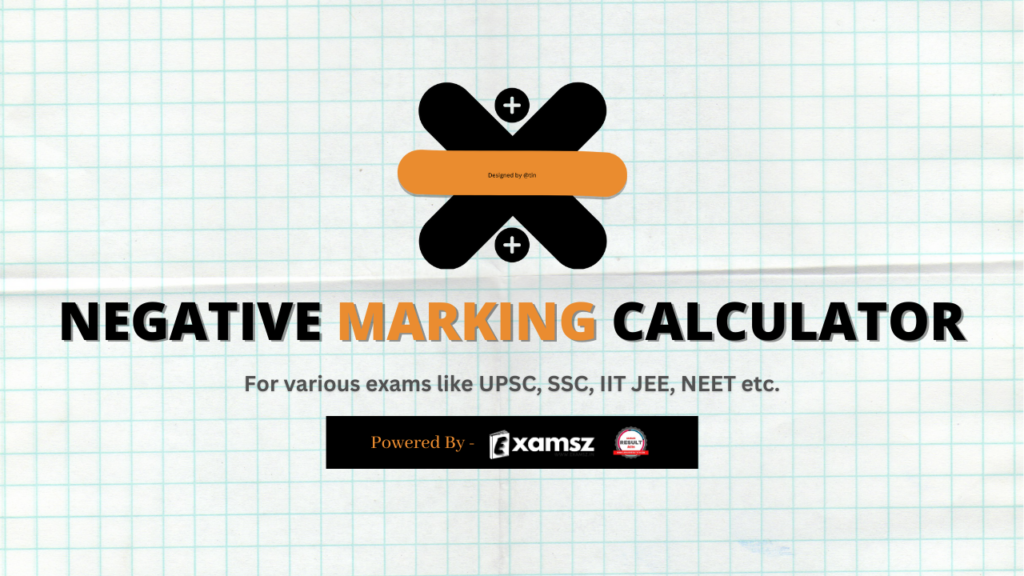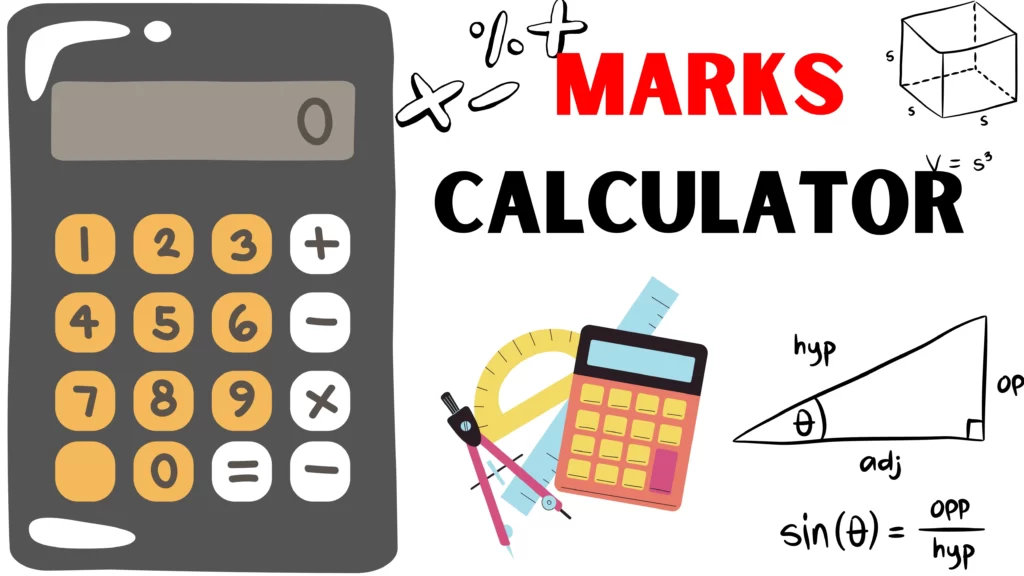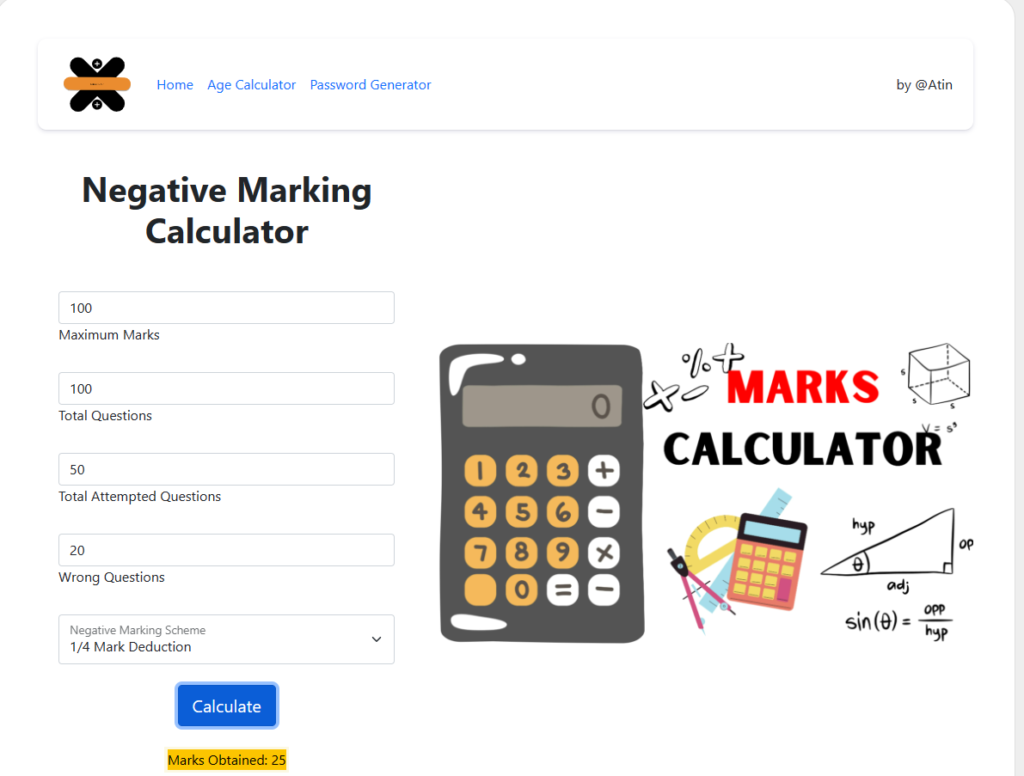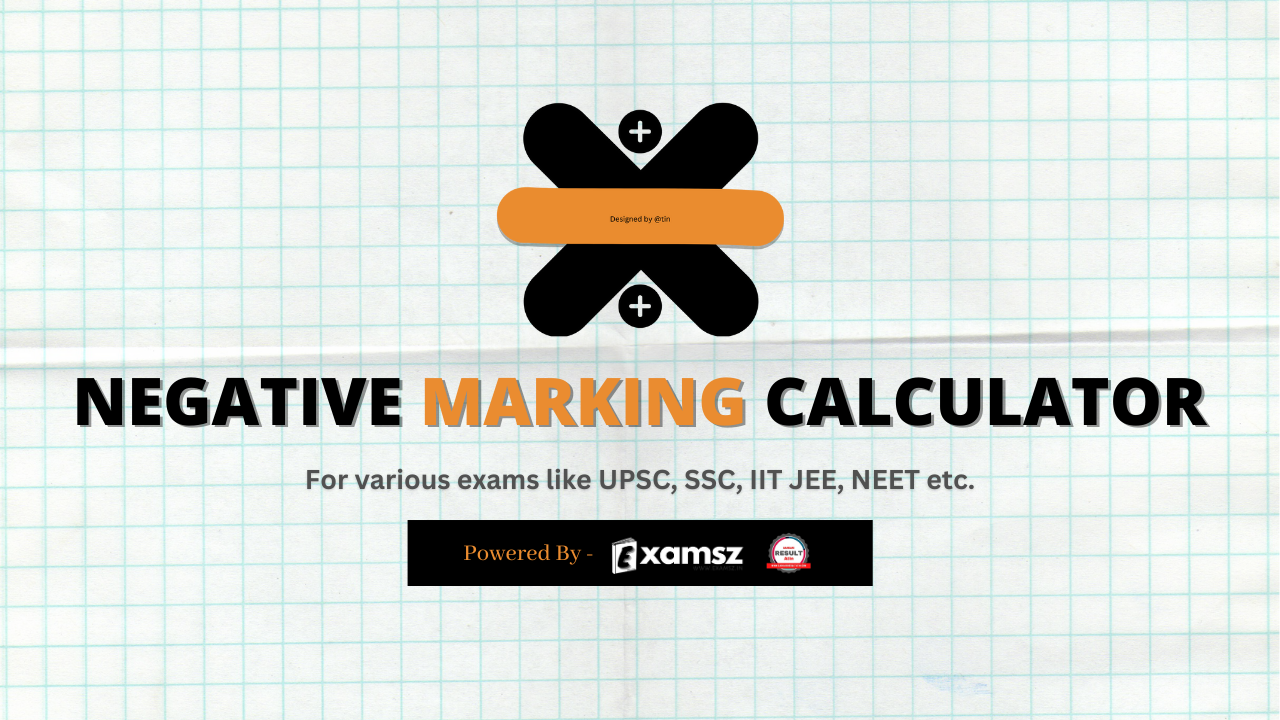
Negative Marking Calculator for UPSC Prelims and other Exams
Negative marking is a scoring system that can often cause a lot of stress and anxiety for students taking competitive exams, such as the UPSC Prelims. It is implemented to discourage guessing and reward those who have a good grasp of the material. Essentially, marks are deducted for incorrect answers, which can be frustrating for test-takers who are unsure of the correct answer.
Fortunately, there are tools available to help students navigate the negative marking system and improve their chances of success. Negative marking calculators, for example, can be incredibly helpful in reducing some of the guesswork involved in answering questions on the exam. These calculators allow students to calculate the total marks they would receive after considering the negative marking penalty for incorrect answers, which can give them a better idea of how to approach each question on the exam.
While negative marking can certainly add an additional layer of challenge to competitive exams, with the right strategies and tools in place, students can feel more confident and prepared when sitting for these tests
A negative marking calculator is a tool that helps test-takers to calculate their expected score on an exam that has a negative marking. It takes into account the number of questions, the marks awarded for each correct answer, and the penalty for incorrect answers, and provides an estimate of the test-taker’s final score. This can be a valuable tool for students who are trying to decide which questions to answer and which to skip, as it can help them to weigh the risks and benefits of guessing.
Using a negative marking calculator is easy. Test-takers simply enter the number of questions in the exam, the marks awarded for each correct answer, and the penalty for incorrect answers, and the calculator does the rest. Some calculators may also allow users to enter the number of questions they are confident about and the number they are unsure about, to provide a more accurate estimate of their final score.
One of the main benefits of using a negative marking calculator is that it can help test-takers to avoid the pitfalls of guessing. In exams with negative markings, guessing can be a risky strategy, as even a single incorrect answer can significantly reduce a student’s final score. With a calculator, students can make informed decisions about which questions to answer, based on their confidence in the material and the potential penalty for guessing.
Another benefit of using a negative marking calculator is that it can help students to manage their time more effectively. By knowing how much each question is worth and the penalty for guessing, students can prioritize their time and focus on the questions that are most likely to yield the highest score. This can be especially important in exams like the UPSC Prelims, where time management is a key factor in success.
In conclusion, a negative marking calculator can be a useful tool for students who are preparing for competitive exams like the UPSC Prelims, SSC CGL, SSC CHSL, IBPS BANKING Exams, and so on. By providing an estimate of their final score and helping them to avoid the pitfalls of guessing, this tool can improve their chances of success and reduce the stress and anxiety associated with negative marking. Students who are preparing for these exams should consider using a negative marking calculator as part of their study plan.
Negative Marking Calculator
A negative marking calculator works by taking into account the negative marking system of a particular exam and calculating the expected score of a candidate based on the number of correct and incorrect answers they have given. The calculator typically asks the user to input the following information:
| 1. The number of correct answers given by the candidate. 2. The number of incorrect answers given by the candidate. 3. The marks awarded for each correct answer. 4. The marks are deducted for each incorrect answer. |
Once this information is entered, the calculator will use the following formula to calculate the expected score:
Obtained score = (Number of correct answers x marks per Question) – (Number of incorrect answers x marks per Question x marks deducted for each incorrect answer)
For example, suppose a candidate has attempted 100 questions in an exam, out of which they have answered 70 questions correctly and 30 questions incorrectly. The exam has a negative marking system where 1 mark is awarded for each correct answer and 0.25 marks are deducted for each incorrect answer. In this case, the expected score of the candidate can be calculated using the formula as follows:
Obtained score = (70 x 1) – (30 x 0.25) = 67.5 marks
A negative marking calculator saves time and reduces the possibility of errors in calculating the expected score manually. It also helps candidates to understand the impact of negative marking on their overall score and plan their exam strategy accordingly.
Negative Marking Scheme of the SSC Exam
The Staff Selection Commission (SSC) is a government organization responsible for conducting various recruitment exams for government jobs in India. Many of these exams have negative markings, which means that for every incorrect answer, a certain number of marks are deducted from the total score.
The negative marking scheme in SSC exams varies depending on the exam. For example, in the Combined Graduate Level (CGL) exam, there is a penalty of 0.50 marks for each incorrect answer in Tier-I and Tier-II exams. In the Combined Higher Secondary Level (CHSL) exam, there is a penalty of 0.25 marks for each incorrect answer in the Tier-I exam.
It is important for SSC aspirants to understand the negative marking scheme in the exam they are preparing for, as it can significantly impact their final score. Guessing blindly or attempting questions without a proper understanding of the concepts can lead to a deduction of marks, which can lower the overall score and reduce the chances of qualifying for the next round.
To minimize the impact of negative marking, SSC aspirants should adopt a strategic approach while attempting the exam. They should focus on attempting questions they are confident about and skip the ones they are unsure about. This will help them avoid unnecessary deduction of marks.
In addition, SSC aspirants can also use techniques such as elimination, approximation, and intelligent guessing to improve their chances of getting the correct answer. Elimination involves ruling out the obviously incorrect options to narrow down the choices, approximation involves making educated guesses based on the available information, and intelligent guessing involves using clues and patterns in the question to arrive at the correct answer.
Overall, understanding the negative marking scheme in SSC exams and adopting a strategic approach can help aspirants to maximize their scores and increase their chances of qualifying for the next round.
Negative Marking Scheme for JEE
The Joint Entrance Examination (JEE) is one of the most competitive engineering entrance exams in India and is used for admission to top engineering colleges in the country, including the Indian Institutes of Technology (IITs). Like many other competitive exams, JEE also has a negative marking scheme.
In JEE, there are two papers – Paper 1 and Paper 2. Both papers have multiple choice questions (MCQs) with four options, and each question carries four marks. However, for every incorrect answer, one mark is deducted from the total score. If a question is left unanswered, there is no negative marking.
The negative marking scheme in JEE is intended to discourage guesswork and reward those who have a good understanding of the material. It is important for JEE aspirants to keep this in mind while attempting the exam, as incorrect answers can significantly reduce the final score.
To minimize the impact of negative marking, JEE aspirants should adopt a strategic approach while attempting the exam. They should focus on attempting questions they are confident about and skip the ones they are unsure about. This will help them avoid unnecessary deduction of marks.
In addition, JEE aspirants can also use techniques such as elimination, approximation, and intelligent guessing to improve their chances of getting the correct answer. Elimination involves ruling out the obviously incorrect options to narrow down the choices, approximation involves making educated guesses based on the available information, and intelligent guessing involves using clues and patterns in the question to arrive at the correct answer.
Overall, understanding the negative marking scheme in JEE and adopting a strategic approach can help aspirants to maximize their scores and increase their chances of qualifying for admission to the top engineering colleges in India. JEE aspirants should also ensure that they have a good understanding of the concepts and have practiced enough questions to build their confidence and improve their speed and accuracy

Negative Marking Scheme for NEET Exam
The National Eligibility cum Entrance Test (NEET) is an all-India medical entrance exam that is conducted for admission to undergraduate medical and dental courses in various colleges across India. Like many other competitive exams, NEET also has a negative marking scheme.
In NEET, each question carries four marks, and for every incorrect answer, one mark is deducted from the total score. However, if a question is left unanswered, there is no negative marking.
The negative marking scheme in NEET is intended to discourage guesswork and reward those who have a good understanding of the material. It is important for NEET aspirants to keep this in mind while attempting the exam, as incorrect answers can significantly reduce the final score.
To minimize the impact of negative marking, NEET aspirants should adopt a strategic approach while attempting the exam. They should focus on attempting questions they are confident about and skip the ones they are unsure about. This will help them avoid unnecessary deduction of marks.
In addition, NEET aspirants can also use techniques such as elimination, approximation, and intelligent guessing to improve their chances of getting the correct answer. Elimination involves ruling out the obviously incorrect options to narrow down the choices, approximation involves making educated guesses based on the available information, and intelligent guessing involves using clues and patterns in the question to arrive at the correct answer.
Overall, understanding the negative marking scheme in NEET and adopting a strategic approach can help aspirants to maximize their scores and increase their chances of qualifying for admission to the medical and dental courses in India. NEET aspirants should also ensure that they have a good understanding of the concepts and have practiced enough questions to build their confidence and improve their speed and accuracy.
This Negative Marking Calculator can be used to calculate the Marks for NEET Exam. It is very useful to calculate accurate marks with a negative marking scheme.
0.25 negative marking calculator
A 0.25 negative marking calculator is a tool used to calculate the score of an exam where each incorrect answer results in a deduction of 0.25 marks from the total score. To use this calculator, you would need to know the total number of questions in the exam, the number of correct answers, and the number of incorrect answers. Here is an example calculation:
Suppose you have taken an exam with 50 questions, and you have answered 40 questions correctly and 10 questions incorrectly. The total marks for the exam are 100.
The formula to calculate the score using a 0.25 negative marking scheme is:
Total Score = (Number of Correct Answers x Marks per Correct Answer) – (Number of Incorrect Answers x Marks per Incorrect Answer)
In this case, the mark per correct answer would be 2 (since the total marks are 100 and there are 50 questions), and the mark per incorrect answer would be -0.25.
Plugging in the values, we get:
Total Score = (40 x 2) – (10 x 0.25) = 80 – 2.5 = 77.5
Therefore, your total score for the exam would be 77.5.

Some Important Links
| Calculate Marks Online [UPSC] | Click Here |
| Calculate Marks Online [SSC] | Click Here |
| Calculate Marks Online [JEE] | Click Here |
| Calculate Marks Online [NEET] | Click Here |
| Calculate Marks Online [CAT] | Click Here |
| Calculate Marks Online [Other Exams] | Click Here |
| Sarkarireultatin Home | Click Here |
| Subscribe to our Youtube channel | Click Here |
How do you calculate 1 3rd negative marking?
Calculating 1/3 negative marking involves deducting one-third of a mark for each incorrect answer on an exam. To calculate the score using this scheme, you need to know the total number of questions in the exam, the number of correct answers, and the number of incorrect answers.
Here’s an example calculation:
Suppose you have taken an exam with 60 questions, and you have answered 45 questions correctly and 15 questions incorrectly. The total marks for the exam are 100.
The marks per question would be 100/60, which is approximately 1.67.
The marks deducted per incorrect answer would be 1.67/3, which is approximately 0.56.
Using these values, we can calculate the total score as follows:
Total Score = (Number of Correct Answers x Marks per Correct Answer) – (Number of Incorrect Answers x Marks Deducted per Incorrect Answer)
Total Score = (45 x 1.67) – (15 x 0.56)
Total Score = 75.15
Therefore, your total score for the exam would be 75.15.
How to calculate 1 3 negative marking in CDS?
The Combined Defense Services (CDS) examination is conducted by the Union Public Service Commission (UPSC) for recruitment into the Indian Military Academy, Indian Naval Academy, Air Force Academy, and Officers Training Academy.
The CDS exam uses a negative marking scheme, where one-third (1/3) of a mark is deducted for each incorrect answer. The marking scheme for the CDS exam is slightly different from other exams, as the exam has different sections and each section has a different number of questions and total marks.
What is 50% negative marking?
50% negative marking means that for every incorrect answer, 50% of the marks allotted for that question will be deducted from the total score. This is a severe negative marking scheme and can significantly impact the total score of an exam.
0.25 Negative Marking means?
0.25 means 1/4th of that mark. You can calculate 0.25 Negative Marking by Marks Calculator developed by https://sarkariresultatin.com/negative-marking-calculator-online .
How to Calculate 1/4 Negative Marking?
1/4 Negative Marking can be calculated by the formulae (Total Score = (Number of Correct Answers x Marks per Correct Answer) – (Number of Incorrect Answers x Marks per Incorrect Answer)) or by Negative Marking Calculator by Sarkariresultatin.




